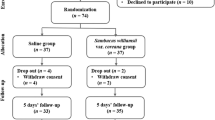Abstract
Purpose
To evaluate the effect of two herbal mouthwashes containing aloe vera and tea tree oil, on the oral health of school children.
Methods
A double-blinded, placebo-controlled prospective interventional study was conducted in school children aged 8–14 years. The study participants were divided into four groups depending upon the mouthwash used: Group 1 (aloe vera), Group 2 (chlorhexidine), Group 3 (tea tree oil) and Group 4 (placebo). The variables studied included plaque index, gingival index and salivary Streptococcus mutans counts, which were recorded at baseline, 4 weeks after supervised mouth rinse and after 2 weeks of stopping the mouth rinse.
Results
A total of 89 boys and 63 girls were included. A statistically significant decrease in all variables was noted after the use of both the herbal preparations at the end of 4 weeks which was maintained after the 2-week washout period (p < 0.001). The difference in variables between groups using aloe vera, Tea tree oil and chlorhexidine, was not statistically significant.
Conclusion
The use of aloe vera and tea tree oil mouthwashes can decrease plaque, gingivitis and S. mutans in the oral cavity in children. The activity of these two agents is comparable to that of chlorhexidine.
Similar content being viewed by others
References
Bonsvoll P, Gjermo P. A comparison between chlorhexidine and some quaternary ammonium compounds with regards to retention, salivary concentration and plaque-inhibiting effects in the human mouth after mouth rinses. Arch Oral Biol. 1978;23:289–94.
Botelho MA, dos Santos RA, Martins JG, et al. Comparative effect of an essential oil mouthrinse on plaque, gingivitis and salivary Streptococcus mutans levels: a double blind randomized study. Phytother Res. 2009;23:1214–9.
Bowden GH. Mutans streptococci caries and chlorhexidine. J Can Dent Assoc. 1996;62(700):703–7.
Carson CF, Hammer KA, Riley TV. Melaleuca alternifolia (tea tree) oil: a review of antimicrobial and other medicinal properties. Clin Microbiol Rev. 2006;19:50–62.
de Oliveira SM, Torres TC, Pereira SL, Mota OM, Carlos MX. Effect of a dentifrice containing aloe vera on plaque and gingivitis control. A double-blind clinical study in humans. J Appl Oral Sci. 2008;16:293–6.
Gaffar A, Afflitto J, Nabi N. Chemical agents for the control of plaque and plaque microflora: an overview. Eur J Oral Sci. 1997;105:502–7.
Groppo FC, Ramacciato JC, Simoes RP, Florio FM, Sartoratto A. Antimicrobial activity of garlic, tea tree oil, and chlorhexidine against oral microorganisms. Int Dent J. 2002;52:433–7.
James P, Worthington HV, Parnell C, et al. Chlorhexidine mouthrinse as an adjunctive treatment for gingival health. Cochrane Database Syst Rev. 2017;3:CD008676. https://doi.org/10.1002/14651858.cd008676.pub2.
Kleber CJ, Putt MS, Muhler JC. Duration and pattern of tooth brushing in childern using a gel or paste dentifrice. J Am Dent Assoc. 1981;103:723–6.
Lee SS, Zhang W, Li Y. The antimicrobial potential of 14 natural herbal dentifrices: results of an in vitro diffusion method study. J Am Dent Assoc. 2004;135:1133–41.
Loe H, Silness J. Periodontal disease in pregnancy 1: prevalence and severity. Acta Odontol Scand. 1967;21:533–51.
Marsh PD. Microbiology of dental plaque biofilms and their role in oral health and caries. Dent Clin N Am. 2010;54:441–54.
McCarney R, Warner J, Iliffe S, van Haselen R, Griffin M, Fisher P. The Hawthorne effect: a randomised, controlled trial. BMC Med Res Methodol. 2007;3(7):30.
Neto CAF, Parolo CCF, Rösing CK, Maltz M. Comparative analysis of the effect of two chlorhexidine mouthrinses on plaque accumulation and gingival bleeding. Braz Oral Res. 2008;22:139–44.
Prabhakar AR, Ahuja V, Basappa N. Effect of curry leaves, garlic and tea tree oil on Streptococcus mutans and Lactobacilli in children: a clinical and microbiological study. Pesq Bras Odontoped Clin Integr João Pessoa. 2009;9:259–63.
Sandström A, Cressey J, Stecksén-Blicks C. Tooth-brushing behaviour in 6–12 year olds. Int J Paediatr Dent. 2011;21:43–9.
Shelton RM. Aloe vera. Its chemical and therapeutic properties. Int J Dermatol. 1991;30:679–83.
Silness J, Loe H. Periodontal disease in children, correlation between oral hygiene and periodontal condition. Acta Odontol Scand. 1964;22:121–35.
Soukoulis S, Hirsch R. The effects of a tea tree oil-containing gel on plaque and chronic gingivitis. Aust Dent J. 2004;49:78–83.
Tandon S, Gupta K, Rao S, Malagi KJ. Effect of triphala mouthwash on the caries status. Int J Ayurveda Res. 2010;1:93–9.
Turesky S, Gilmore ND, Glickman I. Reduced plaque formation by the chloromethyl analogue of victamine C. J Periodontol. 1970;41:41–3.
Van Dijk W. Negatively charged polysaccharides derivable from aloe vera. United States Patent, 2005. Pub. No. US 2005/0019433 A1. www.freepatentsonline.com.
Villalobos OJ, Salazar CR, De Sanchez GR. Effect of aloe vera compound mouthwash in plaque and gingival inflammation. Acta odontol Acta Odontol Venez. 2001;39:16–24.
Wynn RL. Aloe vera gel: update for dentistry. Pharmacology today. Gen Dent. 2005;5:6–9.
Author information
Authors and Affiliations
Corresponding author
Ethics declarations
Conflict of interest
The authors declare that they have no conflict of interest.
Additional information
Publisher's Note
Springer Nature remains neutral with regard to jurisdictional claims in published maps and institutional affiliations.
Rights and permissions
About this article
Cite this article
Kamath, N.P., Tandon, S., Nayak, R. et al. The effect of aloe vera and tea tree oil mouthwashes on the oral health of school children. Eur Arch Paediatr Dent 21, 61–66 (2020). https://doi.org/10.1007/s40368-019-00445-5
Received:
Accepted:
Published:
Issue Date:
DOI: https://doi.org/10.1007/s40368-019-00445-5




